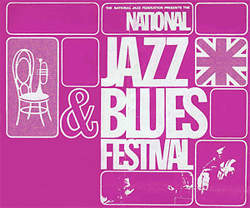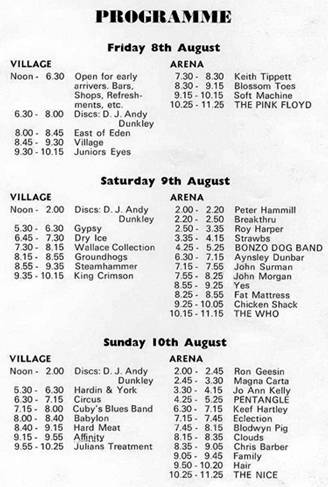
Plumpton Race Track.
Streat.
East Sussex.
The Archive.
updated June 2021
 |
Plumpton Race Track. Streat. East Sussex. |
 |
The use of two performance areas is a tradition that stretched back to 1965 at least, when there used to be a small performance tent in which luminaries such as The Rolling Stones and Fleetwood Mac made their festival debut's. |
All photos on this page courtesy Repfoto© 1969.
You can view many great photos of almost all the acts at the festival here at Repfoto or by clicking on the images
The Who just have to be the most exciting rock band in the world. They brought Saturday to a shattering climax which included a 45-minute excerpt from their pop opera "Tommy".
Roy Harper |
Other
highlights in a great day were Yes, the Bonzos - and the audience themselves
who kept their cool, in behaviour at least, right through the Who's wildest
moment. The Strawbs proved to be a great - if not an incredible - string band. Dave Cousins and Tony Hooper on guitars were supported for the first time by bass and cello and the overall sound was strong but peaceful and came over clearly. A pleasing formula of fine vocals applied to good melodies and direct unpretentious lyrics, including "We'll Meet Again Sometime", "Poor Jimmy Wilson", "Josephine For Better Or Worse" and the witty "Man Who Called Himself Jesus". They won strong applause. |
The
Bonzos came on strong with their usual erratic mixture of inspired lunacy
and schoolboy foolishness. Viewed objectively their act is a ludicrous
shamble. But they put it over with the kind of gusto and apparent amateurishness
which defies criticism. The Who drummer Keith Moon joined them, glasses of ale were produced, and it seemed likely they would break into "Give Booze A Chance." But finally they launched into a splendid looning cacophony on "Breathalyser Baby" with Moon thundering away and a monstrous plastic balloon snaking across the stage. The
John Surman Octet kicked off the evening show with drummer Tony Oxley
as special guest. They blew some meaty jazz and they - together with the
Don Ellis records played during the breaks - must have won quite a lot
of new friends for jazz. |
The late and throroughly inestimable Viv Stanshall of the Bonzos |
British
blues bands have been knocked a lot recently and it must be admitted that the
sound has palled. In the hands of groups like Aynsley Dunbar and Chicken Shack
it retains a lot of power and authority but neither group was outstanding. Aynsley
Dunbar played a hard, aggressive set, sparked by some fine drumming. Chicken
Shack made a happier, jumping sound. Stan Webb played fast exciting guitar but
his somewhat frantic style suffered by comparison with some of the more relaxed
styles heard during the evening.
Yes |
Hit
of the show, apart from the Who, were quite definitely Yes. They stole
the show in the same way that Jethro Tull did last year. Their distinctive vocalist, John Anderson, was impressive on "Something's Coming" and "Then" and bassist Chris Squire shone on " It's Love." Yes have a distinctly jazzy feel, and this was strengthened when they were joined by none other than jazz singer Jon Hendricks. His duet with John Anderson on Steve Stills' "Everydays" was applauded long and hard. Who says the festival is neglecting jazz! After
the beauty and subtlety of the "Tommy" album, it was great to be reminded
that the Who are also probably the greatest hard rock act around - not
that they are around often enough. |
Daltry's
vocals get better and better and Townshend extracts more brute power from his
instrument than any other guitarist on the scene. Moon, for all his looner image,
is a tremendous drummer and John Entwistle underpins the whole thing with his
pounding, relentless bass lines. After Tommy came shattering versions of "Summertime
Blues" and "Substitute" which must have prompted any aspiring rock group to
jack it all in. Then finally they thundered into an untitled, mind-blistering
rave-up with the traditional guitar smashing, mike-bashing finale.
| Highspot
of Sunday was the merging of the talents of Keith Emerson, the brilliant
young organist with the Nice, and Mr Joseph Egar, the enthusiastic and extremely
hip conductor of the New York Philharmonic. In a courageous blow against the huge barriers between pop music and the classics, the Nice played three pieces in conjunction with 41 string and horn players, including members of the London Symphony Orchestra. It was a nerve-racking experience for the musicians and their fans. Many silent prayers were offered that (a) the music would work and (b) the bulk of the crowd would react favourably. At the end of the experiment the cheers drowned sighs of relief. "It worked!" was the cry backstage later as Nice manager Tony Stratton-Smith bought drinks for Mr. Egar and Keith, Lee Jackson and Brian Davison were congratulated by fellow groups and journalists. |
The Nice and orchestra |
Keef Hartley |
However
Linda Kendrick sang beautifully and her song about people being cruel
and unfeeling was very apt in view of the hurling of abuse and rubbish
that greeted their appearance. Their flower power songs underlined just
how dead is flower power. Family's
drummer and guitarist were electrically exciting and Roger's yelling is
always fine entertainment. Blodwyn Pig are a heavy band and Mick Abrahams
played "Cats Squirrel" nicely, but they didn't do much that struck me
as new. |
The early festivals.
You can find out the complete
line ups of the first festivals if you follow the links below.
|
|
|
|
|
Festivals 65-83
Most of these have fairly complete documentation .
| |
|
|
|
|
| |
|
|
|
|